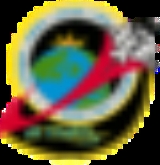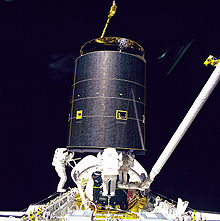
STS-49
Encyclopedia
Mission parameters
- MassMassMass can be defined as a quantitive measure of the resistance an object has to change in its velocity.In physics, mass commonly refers to any of the following three properties of matter, which have been shown experimentally to be equivalent:...
:- Orbiter landing with payload: 91214 kilograms (201,092.4 lb)
- Payload: 14618 kilograms (32,227.2 lb)
- PerigeePerigeePerigee is the point at which an object makes its closest approach to the Earth.. Often the term is used in a broader sense to define the point in an orbit where the orbiting body is closest to the body it orbits. The opposite is the apogee, the farthest or highest point.The Greek prefix "peri"...
: 268 kilometres (166.5 mi) - Apogee: 341 kilometres (211.9 mi)
- InclinationInclinationInclination in general is the angle between a reference plane and another plane or axis of direction.-Orbits:The inclination is one of the six orbital parameters describing the shape and orientation of a celestial orbit...
: 28.35° - PeriodOrbital periodThe orbital period is the time taken for a given object to make one complete orbit about another object.When mentioned without further qualification in astronomy this refers to the sidereal period of an astronomical object, which is calculated with respect to the stars.There are several kinds of...
: 90.6 min
Space walks
- Thuot and Hieb – EVA 1
- EVA 1 Start: 10 May 1992 – 20:40 UTC
- EVA 1 End: 11 – 0 May:23
- Duration: 3 hours, 43 minutes
- Thuot and Hieb – EVA 2
- EVA 2 Start: 11 May 1992 – 21:05 UTC
- EVA 2 End: 12 – 2 May:35 UTC
- Duration: 5 hours, 30 minutes
- Thuot, Hieb and Akers – EVA 3
- EVA 3 Start: 13 May 1992 – 21:17 UTC
- EVA 3 End: 14 – 5 May:46 UTC
- Duration: 8 hours, 29 minutes
- Thornton and Akers – EVA 4
- EVA 4 Start: 14 May 1992 – ~21:00 UTC
- EVA 4 End: 15 May, ~05:00 UTC
- Duration: 7 hours, 44 minutes
Mission highlights
Intelsat VI (F-3) satellite, stranded in an unusable orbit since launch aboard a Titan vehicle in March 1990, was captured by crewmembers during an EVA (extra-vehicular activityExtra-vehicular activity
Extra-vehicular activity is work done by an astronaut away from the Earth, and outside of a spacecraft. The term most commonly applies to an EVA made outside a craft orbiting Earth , but also applies to an EVA made on the surface of the Moon...
) and equipped with a new perigee kick motor. The Satellite was subsequently released into orbit and the new motor fired to put the spacecraft into a geosynchronous orbit for operational use.

Kilogram
The kilogram or kilogramme , also known as the kilo, is the base unit of mass in the International System of Units and is defined as being equal to the mass of the International Prototype Kilogram , which is almost exactly equal to the mass of one liter of water...
communications satellite. An Assembly of Station by EVA Methods (ASEM) structure was erected in the cargo bay by the crew to serve as a platform to aid in the hand capture and subsequent attachment of the capture bar.
A planned EVA also was performed by astronauts Thornton and Akers as part of the ASEM experiment to demonstrate and verify maintenance and assembly capabilities for Space Station Freedom. The ASEM space walk, originally scheduled for two successive days, was cut to one day because of the lengthy Intelsat retrieval operation.
Other "payloads of opportunity" experiments conducted included: Commercial Protein Crystal Growth (CPCG), Ultraviolet Plume Imager (UVPI) and the Air Force Maui Optical Station (AMOS) investigation. Mission was extended two days to complete objectives.
The following records were set during the STS-49 mission:
- First flight of the shuttle EndeavourSpace Shuttle EndeavourSpace Shuttle Endeavour is one of the retired orbiters of the Space Shuttle program of NASA, the space agency of the United States. Endeavour was the fifth and final spaceworthy NASA space shuttle to be built, constructed as a replacement for Challenger...
- First EVA involving three astronauts.
- First and second longest EVA to date: 8 hours and 29 minutes and 7 hours and 45 minutes.
- First Shuttle mission to feature four EVAs.
- EVA time for a single Shuttle mission: 25 hours and 27 minutes, or 59:23 person hours.
- First Shuttle mission requiring three rendezvous with an orbiting spacecraft.
- First use of a drag chute during a Shuttle landing.
See also
- Space scienceSpace scienceThe term space science may mean:* The study of issues specifically related to space travel and space exploration, including space medicine.* Science performed in outer space ....
- Space shuttleSpace ShuttleThe Space Shuttle was a manned orbital rocket and spacecraft system operated by NASA on 135 missions from 1981 to 2011. The system combined rocket launch, orbital spacecraft, and re-entry spaceplane with modular add-ons...
- List of space shuttle missions
- List of human spaceflights chronologically
- Nikon NASA F4Nikon NASA F4The Nikon NASA F4 Electronic Still Camera was one of the first and rarest fully digital cameras ever. Constructed for NASA, it was first flown in September 1991 on board the Space Shuttle Discovery, mission STS-48...

